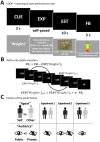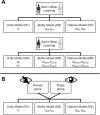Negativity-bias in forming beliefs about own abilities
- PMID: 31594967
- PMCID: PMC6783436
- DOI: 10.1038/s41598-019-50821-w
Negativity-bias in forming beliefs about own abilities
Abstract
During everyday interactions people constantly receive feedback on their behavior, which shapes their beliefs about themselves. While classic studies in the field of social learning suggest that people have a tendency to learn better from good news (positivity bias) when they perceive little opportunities to immediately improve their own performance, we show updating is biased towards negative information when participants perceive the opportunity to adapt their performance during learning. In three consecutive experiments we applied a computational modeling approach on the subjects' learning behavior and reveal the negativity bias was specific for learning about own compared to others' performances and was modulated by prior beliefs about the self, i.e. stronger negativity bias in individuals lower in self-esteem. Social anxiety affected self-related negativity biases only when individuals were exposed to a judging audience thereby potentially explaining the persistence of negative self-images in socially anxious individuals which commonly surfaces in social settings. Self-related belief formation is therefore surprisingly negatively biased in situations suggesting opportunities to improve and this bias is shaped by trait differences in self-esteem and social anxiety.
Conflict of interest statement
The authors declare no competing interests.
Figures





Similar articles
-
Social anxiety is characterized by biased learning about performance and the self.Emotion. 2017 Dec;17(8):1144-1155. doi: 10.1037/emo0000296. Epub 2017 Mar 30. Emotion. 2017. PMID: 28358557 Free PMC article.
-
A Reduced Self-Positive Belief Underpins Greater Sensitivity to Negative Evaluation in Socially Anxious Individuals.Comput Psychiatr. 2021 Apr 28;5(1):21-37. doi: 10.5334/cpsy.57. Comput Psychiatr. 2021. PMID: 34212077 Free PMC article.
-
Lack of optimistic bias during social evaluation learning reflects reduced positive self-beliefs in depression and social anxiety, but via distinct mechanisms.Sci Rep. 2024 Sep 28;14(1):22471. doi: 10.1038/s41598-024-72749-6. Sci Rep. 2024. PMID: 39341892 Free PMC article.
-
Cognitive-behavioral models of social anxiety disorder.Psychiatr Clin North Am. 2001 Dec;24(4):753-71. doi: 10.1016/s0193-953x(05)70261-6. Psychiatr Clin North Am. 2001. PMID: 11723631 Review.
-
Not all emotions are created equal: the negativity bias in social-emotional development.Psychol Bull. 2008 May;134(3):383-403. doi: 10.1037/0033-2909.134.3.383. Psychol Bull. 2008. PMID: 18444702 Free PMC article. Review.
Cited by
-
Characterization of the Core Determinants of Social Influence From a Computational and Cognitive Perspective.Front Psychiatry. 2022 Apr 18;13:846535. doi: 10.3389/fpsyt.2022.846535. eCollection 2022. Front Psychiatry. 2022. PMID: 35509882 Free PMC article. Review.
-
Threat induction biases processing of emotional expressions.Front Psychol. 2022 Nov 24;13:967800. doi: 10.3389/fpsyg.2022.967800. eCollection 2022. Front Psychol. 2022. PMID: 36507050 Free PMC article.
-
A corticostriatal pathway mediating self-efficacy enhancement.Npj Ment Health Res. 2022 Jul 8;1(1):6. doi: 10.1038/s44184-022-00006-7. Npj Ment Health Res. 2022. PMID: 38609484 Free PMC article.
-
Negativity drives online news consumption.Nat Hum Behav. 2023 May;7(5):812-822. doi: 10.1038/s41562-023-01538-4. Epub 2023 Mar 16. Nat Hum Behav. 2023. PMID: 36928780 Free PMC article.
-
Self-beneficial belief updating as a coping mechanism for stress-induced negative affect.Sci Rep. 2021 Aug 24;11(1):17096. doi: 10.1038/s41598-021-96264-0. Sci Rep. 2021. PMID: 34429447 Free PMC article.

